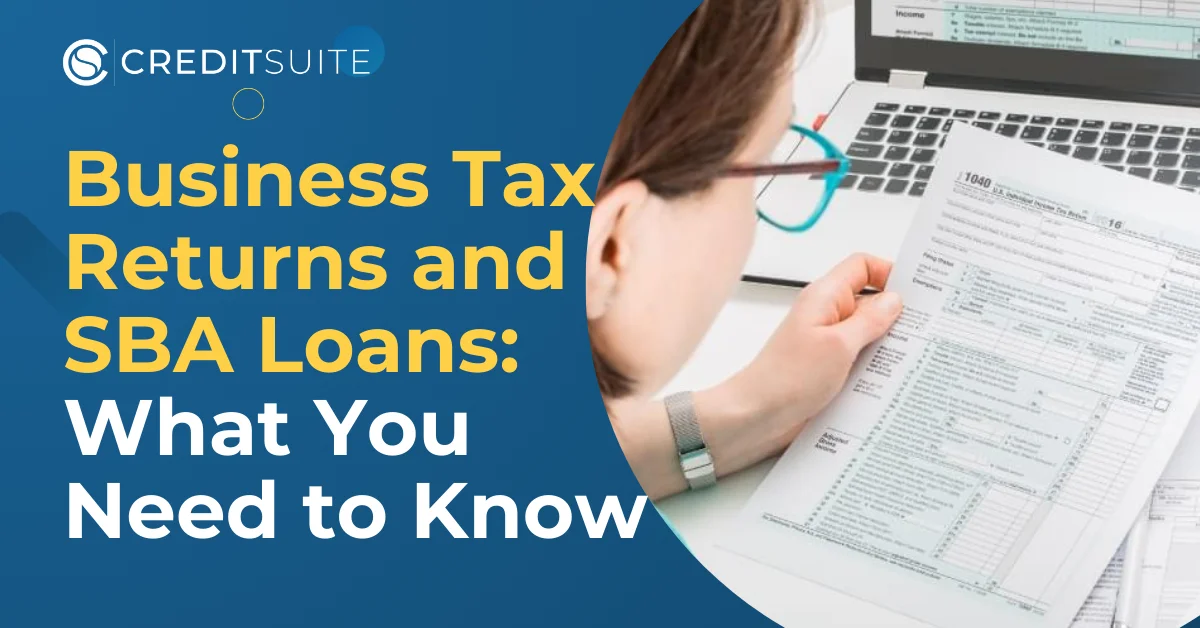The Small Business Administrations, Your Business Tax Returns, and You
For businesses seeking financing from the SBA, understanding all your requirements is necessary. Here’s what the SBA wants. And here’s how the SBA educates entrepreneurs on how to file their business tax returns. Because what the SBA teaches business owners is what they want to see.
Your Business Tax Returns
Filling out your business tax returns right is Job One. The SBA suggests entrepreneurs work with accounting and/or tax professionals. Well-prepared, thorough forms do more than help you get an SBA loan. They also help keep your business from an audit.
This page contains affiliate links to products. We may receive a commission for purchases made through these links.
Necessary Business Tax Returns Documents for an SBA Loan
 You must complete and sign IRS Form 4506-T. Each principal owning 20% or more of the business must sign. Every general partner or managing member must sign. Any owner with more than a 50% ownership in an affiliate business must sign. Affiliates include business parent, subsidiaries, and/or businesses with common ownership or management. Provide complete copies, including all schedules, of the most recent Federal income tax returns for the business. Or provide an explanation if not available.
You must complete and sign IRS Form 4506-T. Each principal owning 20% or more of the business must sign. Every general partner or managing member must sign. Any owner with more than a 50% ownership in an affiliate business must sign. Affiliates include business parent, subsidiaries, and/or businesses with common ownership or management. Provide complete copies, including all schedules, of the most recent Federal income tax returns for the business. Or provide an explanation if not available.
Potential Extra Tax Documents Needed for an SBA Loan
These include complete copies, with schedules, of the most recent Federal tax returns for each principal owning 20% or more of the business. You also must supply them from each general partner or managing member. And supply them from each affiliate if any owner has more than a 50% ownership in the affiliate business. Affiliates include, but are not limited to, business parents and subsidiaries. Plus other businesses with common ownership or management. If the most recent return is not filed, a year-end profit and loss statement and balance sheet for that tax year is acceptable.
For 2020/2021 PPP Loans
You did not have to file 2019 Taxes before applying for the loan. But businesses had to submit IRS form 4506-T. This gives the SBA access to historical business tax returns. Owners with more than a 50% stake in an affiliate business must sign the form. Principals owning 20% or more of the applicant business much also sign. Each partner or managing partner must sign.
Tax Forms that Partnerships Need to Fill Out for SBA Loans
Files Form 1065, US Partnership Return of Income – information only. Each partner gets a Schedule K-1 (Form 1065): Partner’s Share of Income Credit, Deductions, etc. (See page 1-13, Pub 1066). Partner completes Schedule E of Form 1040. Subject to Self-Employment Tax. Use Publication 541.
Partnerships must have a written partnership agreement. It’s best if an attorney drafts it, as accountants cannot give legal advice. The IRS advises partners to spend the money now for a proper set-up. This will save long and expensive battles in the future.
Tax Forms that Corporations Need to Fill Out for SBA Loans
S Corporation (S-Corp) – Files Form 1120S. You can elect to be taxed like a partnership. Use Form 2553 to make this election. You will need to file Form 2553 by the 15th day of the 3rd month for the year, to be treated as an S Corp. An S-Corp does not pay tax on income from daily operations.
S Corporations
All income, losses, deductions, and credits an S-Corp generates pass through to shareholder(s). Shareholder gets Schedule K-1 (Form 1120S): Shareholder’s Share of Income, Credits, Deductions, etc.
The shareholder completes Schedule E of Form 1040. An S Corporation is NOT Subject to self-employment tax (SE Tax). But wages are subject to FICA. Also check Form 1120S Instructions and Form 2553.
C Corporations
A C corporation files Form 1120 US Corporation Income Tax Return. The law treats corporations as legal entities, treated apart from their owners. This affords individual liability protection. Shareholders get dividends with a 1099-DIV form. Employees get Form W-2.
Employees of a C corporation are NOT subject to self-employment tax (SE Tax). But they will still have to pay income tax on their earnings. Corporate shareholders should check Publication 542. Note: there is possible double taxation with a C corporation
Tax Forms that Limited Liability Companies (LLCs) Need to Fill Out for SBA Loans
File a Certificate of Formation with SOS to form an LLC. This is not a federal tax entity (see Publication 3402). An LLC with more than one member is often considered a partnership. A single member LLC tends to be a “Disregarded Entity” and it files as Sole Proprietor.
An LLC can elect a C-Corporation treatment (using Form 8832), or an S-Corporation (using Form 2553). LLCs are popular. Owners have limited personal liability for the debts and actions of the LLC. This is without many of the formalities of a corporation.
Tax Forms that Sole Proprietorships Need to Fill Out for SBA Loans
This is the most common entity type. 23 million taxpayers filed as Schedule C in 2014. It is the simplest and cheapest form of business entity. You form it with one owner. You will need to file a Master License Application from the Dept. of Revenue (DOR) for your state.
In sole proprietorships, income flows to the individual via Schedule C.
One major drawback is the owner cannot be on the payroll. You will need to budget with care. The owner makes estimated tax payments. Per the IRS, anyone considering a sole proprietorship should talk to accounting and/or tax professionals. See if this setup is right.
Record Keeping Requirements for All Businesses
Records must support income and deductions that show amount, time, place, purpose. You must keep receipts, sales slips, invoices, bank deposit slips, and canceled checks. You must also keep other documents to substantiate income and deductions. Use a separate bank account for business.
Accounting Methods the IRS Accepts
The IRS accepts cash accounting and the accrual accounting methods.
With the cash accounting method, you report income when you get it. And you deduct expenses when they are actually paid. But it’s good for no more than $1 million in sales. This works for most businesses.
With the accrual accounting method, you report income when you earn it. This is regardless of when paid. And you deduct expenses when incurred regardless of when paid.
For both methods, see Publication 538.
The SBA and IRS Rules
The SBA of course insists that you fill out all forms right, report all income and losses. Take nothing but the deductions to which you’re entitled. The SBA provides detailed information on what it expects to see on your business tax returns. It’s identical to what the IRS expects to see on your business tax returns.
Taxes and Your Business Income
This includes all income your business gets unless excluded by law. This means income from sale of product or for your services. This includes bartering (Form 1099-B). You must include other types of income. The IRS advises business owners to keep good records.
Taxes and Your Business Expenses
To be deductible, expenses must pass certain tests. First, the expense must be ordinary. It must be necessary to your business. You must incur and/or pay it.
Amortizing Startup Costs
You can choose to amortize some startup costs for setting up your business over a period of 180 months (15 years). A start-up cost is amortizable if it meets both these tests. It is a cost you could deduct if you paid or incurred it to operate an existing trade or business (in the same field). And it must be a cost you pay or incur before the day your active trade or business begins. There is a $50,000 limit.
Car and Truck Expenses
If you use no more than four vehicles at the same time for business purposes, you may use the standard mileage rate. Use the standard mileage rate the first year. Otherwise, you can’t use the standard mileage rate on a vehicle after the first year of business use. In later years you can alternate between standard mileage and actual expenses. But if you used actual expenses in the first year you can NOT alternate. Publication 463: Travel, Entertainment, Gift and Car Expenses covers this.
But commuting expenses are not allowed. Deductible local transportation expenses may include getting from one place of work to another. They can also include visiting clients or customers; and going to a business meeting.
Depreciation
Depreciation is an annual deduction. The IRS allows it to recover the cost of your investment property beyond the current tax year. It is a decrease in the value of property over time. You must use the property in the business. It must have a determinable life longer than 1 year. Must be something that wears out, decays, gets used up, becomes obsolete or loses value from natural causes.
You cannot depreciate:
- Land
- Intangibles (like business good will)
- Inventory
- Leased property
- Property outside the US
- Property used for business less than 50% of the time
Travel Expenses
Ordinary and necessary expenses for travel away from the business, not your home. Travel expenses include:
- Fares (air, taxis, etc.)
- Baggage and shipping
- 50% of meals
- Lodging
Entertainment Expenses
These must be ordinary and necessary. They must meet either the Directly Related or Associated Tests. No more than 50% deductible whether you use Per Diem or Actual. Must allocate business part. Keep receipts that show time, place, and purpose of entertainment (includes meals). See Publication 463: Travel, Entertainment, Gift and Car Expenses.
Business Use of Your Home on Your Business Tax Returns
Many businesses start out of homes these days. The SBA says the IRS puts limitations on deductions. Good recordkeeping, as always, is necessary. But some deductions are possible.
See Form 8829, Expenses of Business Use of Home, and Publication 587, Business Use of Home. Your business use of your home must pass certain tests for acceptance.
Exclusive use means you must use a specific area of home for trade or business and nothing else. But there is an exception for storage and day care facilities. Regular use means using an area on a regular basis. Trade or Business use means using an area in connection with a trade or business.
Business Use of Home Test
To declare part of your home as being for a business use, you must meet these criteria. You must use a part of your home exclusively on a regular basis as your principal place of business. Or it can be a place of business your patients, clients, or customers use to meet or deal in the normal course of your business. Or it can be a separate structure you use in connection with your business.
Self-Employment Tax
The self-employment tax is Social Security and Medicare taxes. Working for someone else they pay half, and you pay half. But working for yourself you pay it all. Sole proprietors and partners may be subject to the SE Tax. If your net profit from self-employment is $400 or more, you must file Form 1040, Schedule SE, Self-Employment Tax.
Avoiding Tax Penalties—and Doing the Right Thing with Your Business Tax Returns
File an accurate, on time, and correct return. There is a 20% accuracy related penalty if you understate tax liability due to:
- Negligence
- Substantial valuation misstatements
- Substantial understatement of tax
There is a 75% civil fraud penalty. For felony criminal fraud it’s a combined penalty of 5%/month, and a 4.5% late filing and 0.5% late payment.
An accurate, on time, and correct return might not get you an SBA loan, by itself. But an inaccurate, late, and/or incorrect return will tank your application for an SBA loan. Not to mention having to pay penalties. So work with a tax or accounting professional. Get your business tax returns right the first time, every time.
Takeaways
In short, the SBA wants to see what the IRS wants to see. There are a variety of forms and schedules to cover a multitude of circumstances. Understand depreciation. Learn how to declare your home as your place of business. Both will help you prepare more accurate and complete business tax returns. And work with a tax or accounting professional to assure your business tax returns are as good as they can be. This helps you get SBA loans and avoid penalties.

